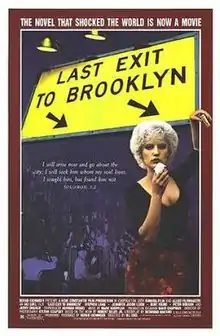Last Exit to Brooklyn (film)
Last Exit to Brooklyn is a 1989 German-British drama film directed by Uli Edel and adapted by Desmond Nakano from Hubert Selby Jr.'s 1964 novel of the same title.[3][4][5]
| Last Exit to Brooklyn | |
|---|---|
 Theatrical release poster | |
| Directed by | Uli Edel |
| Produced by | Bernd Eichinger |
| Screenplay by | Desmond Nakano |
| Based on | Last Exit to Brooklyn by Hubert Selby Jr. |
| Starring | |
| Music by | Mark Knopfler |
| Cinematography | Stefan Czapsky |
| Edited by | Peter Przygodda |
Production company | |
| Distributed by | Neue Constantin Film |
Release date |
|
Running time | 103 minutes[1] |
| Country | West Germany United Kingdom |
| Language | English |
| Budget | $17 million[2] |
| Box office | $1,730,005 |
Plot
The difficult lives of unionized workers, prostitutes, and drag queens in a working class Brooklyn neighborhood are portrayed, including drugs, crime and violence.
Cast
- Stephen Lang as Harry Black
- Jennifer Jason Leigh as Tralala
- Burt Young as Big Joe
- Peter Dobson as Vinnie
- Jerry Orbach as Boyce
- Stephen Baldwin as Sal
- Jason Andrews as Tony
- James Lorinz as Freddy
- Sam Rockwell as Al
- Maia Danziger as Mary Black
- Camille Saviola as Ella
- Ricki Lake as Donna
- Cameron Johann as Spook
- John Costelloe as Tommy
- Christopher Murney as Paulie
- Alexis Arquette as Georgette
- Mark Boone Junior as Willie
- Rutanya Alda as Georgette's mother
Production
There had been several attempts to adapt Last Exit to Brooklyn into a film prior to this version. One of the earliest attempts was made by producer Steve Krantz and animator Ralph Bakshi, who wanted to direct a live-action film based on the novel. Bakshi had sought out the rights to the novel after completing Heavy Traffic, a film which shared many themes with Selby's novel. Selby agreed to the adaptation, and actor Robert De Niro accepted the role of Harry in Strike. According to Bakshi, "the whole thing fell apart when Krantz and I had a falling out over past business. It was a disappointment to me and Selby. Selby and I tried a few other screenplays after that on other subjects, but I could not shake Last Exit from my mind."[6]
Some scenes for the film were shot at Montero's Bar and Grill, which was owned by Pilar Montero and her husband.[7]
Reception
The film received positive reviews, garnering a 78% rating on review aggregator website Rotten Tomatoes,[8] and winning a few critics' awards for Leigh's portrayal of Tralala, though its limited distribution and downbeat subject matter prevented it from becoming a commercial success.
See also
References
- "LAST EXIT TO BROOKLYN (18)". British Board of Film Classification. 22 September 1989. Retrieved 10 October 2014.
- Travers, Peter (4 May 1990). "Last Exit to Brooklyn". Rolling Stone. Retrieved 24 August 2020.
- Vincent Canby (2 May 1990). "A Brutal, Elegiac 'Last Exit,' Unrelieved by Hope". The New York Times.
- Shelia Benson (4 May 1990). "A Brutal, Theatrical Mix Runs Through Edel's 'Last Exit to Brooklyn'". The Los Angeles Times.
- Anthony DePalma (27 April 2004). "Hubert Selby Jr. Dies at 75; Wrote 'Last Exit to Brooklyn'". The New York Times.
- "Last Exit to Brooklyn". AMC.
- "Pilar Montero, Bar Owner and Link to a Seafaring Past, Dies at 90". The New York Times. 21 January 2012. Retrieved 30 March 2015.
- "Last Exit to Brooklyn". Rotten Tomatoes. Flixster. Retrieved 10 October 2014.